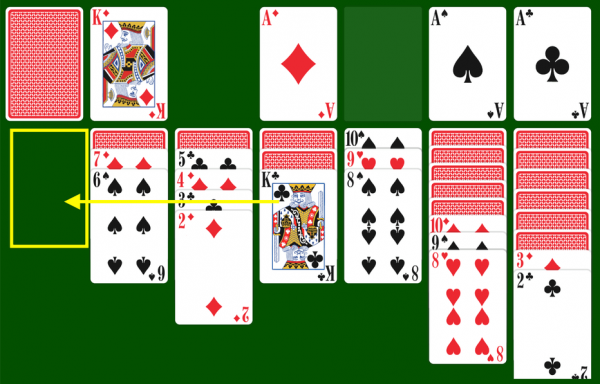Ah, solitaire. It’s a classic card game, and one that’s still enjoyed by many people around the world, largely thanks to its free availability and addictive qualities. The rules of solitaire are extremely simple; all you need to do is build four stacks of cards, one for each suit, at the bottom of the board, and you’ve won. However, it’s a little more complex than that, of course, or else solitaire wouldn’t be one of the most popular games in the world! Here are 10 fascinating solitaire facts for you to think about next time you play a game.
1. You can play it for free
You don’t even need a physical deck of cards to play solitaire. In fact, the main way that most people of a certain age discover the game is probably through the free built-in Microsoft Windows version, but there are other places you can go to play solitaire online, such as https://www.play-solitaire.com/. There, you’ll find the classic Klondike variation of the game (more on which in a moment) rendered in a simple and easy fashion. Enjoy!
2. There are lots of different versions
The version of solitaire with which most Western card gamers are familiar is probably Klondike, which is the game in which you must create stacks of card suits. In actuality, Klondike is just one of several different solitaire variations, with others calling for different rules or different modes of play. There are even versions of solitaire that use mahjong tiles or pegs rather than cards. Did you know that the classic “match two” memory game, which involves flipping cards over and remembering their position, is also a solitaire variant?
3. You can win most games
You’ve probably experienced that moment where you’re facing down a game of solitaire that looks impossible to win. While it’s definitely possible to play yourself into a corner in solitaire, the fact is that the vast majority of games are actually winnable from the outset, and it’s poor strategic decision-making (or just plain bad luck) that renders them unwinnable. Bear that in mind the next time you metaphorically flip the solitaire board because you’ve lost again (we’ve been there).
4. Some people are pro solitaire players
You might need to blink and read that one again, but it’s true; some people can actually make a living playing solitaire. Back in 2001, professional gamer Mary Dion managed to rack up $250,000 playing solitaire (and other games) on various sites, so it’s definitely possible to make money playing solitaire. It’s essentially akin to being a professional gambler; since you can’t guarantee the outcome of a solitaire game, you’re gambling, although your chances of winning are higher than with trad gambling, of course.
5. Windows Solitaire has humble beginnings
You’re probably imagining that the Windows version of solitaire was created by some kind of savvy game developer with a huge amount of experience, right? Well, that’s not the case. Back in 1990, the game appeared on Windows 3.0, programmed by intern Wes Cherry. It was developed in the summer of 1988, although the card deck was designed by Susan Kare, who also contributed a huge amount to Mac interface design in the mid-1980s.
6. The highest possible score is 24,113
If you’re playing an absolute blinder of a game in Microsoft Solitaire, then the best possible score you can achieve is 24,113. This score includes bonus points for time, so you’re playing as fast as you possibly can and still playing accurately in this scenario, which is pretty difficult to do. If you don’t factor in bonus points for time – if you’re playing as leisurely a game as possible – then the best possible Microsoft Solitaire score you can achieve is 745.
7. The name has pretty obvious origins
If you’re any kind of amateur etymologist, you’ve probably already spotted the “solit” root of “solitaire”, and you’d be right to do so. It’s a word that means “alone” or “isolated”, and it has its roots in French and Latin, by turn. The word originally referred to a hermit or a person who lives alone, and it eventually came to refer to a card game that could be played entirely by oneself. Fun fact: it also means a single gem, usually a diamond, set into something.
8. You can cheat at solitaire
In what is perhaps the ultimate act of redundancy and pointlessness, it’s actually possible to cheat at solitaire. By holding down Ctrl and Alt and Shift while you’re turning over decks, you can turn over a single card at a time, which usually makes most games trivial. Of course, since this is a game you’re playing entirely by yourself, you’re only cheating yourself by doing this. It’s also possible to cheat at solitaire with a physical deck of cards, obviously; just turn over whichever card you want!
9. The earliest variants of solitaire appeared in the 18th century
Obviously, nobody can truly know exactly when solitaire first appeared; the origins of games like solitaire are usually much messier than being able to point to a single moment. However, we do know that early records of solitaire-style games began to appear in the 18th century, and that the term Patiencespiel, which could refer to a solitaire-style game, entered the German lexicon in the late 18th century. Solitaire is older than you might think!
10. Microsoft Solitaire could have had a boss key
The intern who designed Microsoft Solitaire, Wes Cherry, refers to something called a “boss key”, which, if you’re not familiar with it, is a button used to hide a program and replace it with something that looks like productivity software. Originally, Microsoft Solitaire contained a boss key that would swap solitaire with a fake Microsoft Excel spreadsheet, but this never made it to the final version. We’re sure this would have been useful for a lot of office workers back in the day!


